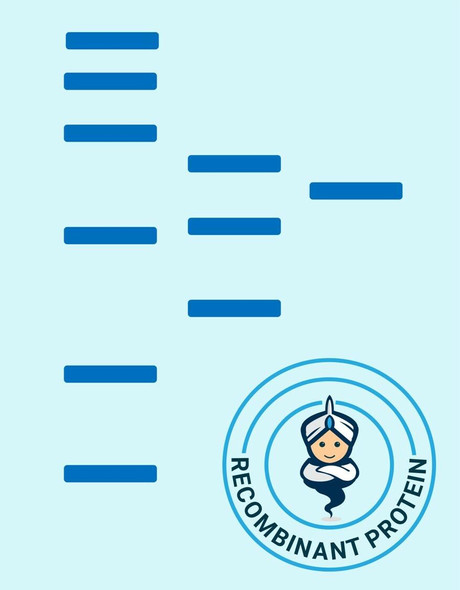Chemokines Recombinant Proteins
Human HCC 1 (66 a.a.) Recombinant Protein (RPPB1158)
- SKU:
- RPPB1158
- Product Type:
- Recombinant Protein
- Species:
- Human
- Uniprot:
- Q16627
- Research Area:
- Chemokines
Description
| Product Name: | Human HCC 1 (66 a.a.) Recombinant Protein |
| Product Code: | RPPB1158 |
| Size: | 10µg |
| Species: | Human |
| Target: | HCC 1 (66 a.a.) |
| Synonyms: | Small inducible cytokine A14, CCL14, Chemokine CC-1/CC-3, HCC-1/HCC-3, HCC-1(1-74), NCC-2, chemokine (C-C motif) ligand 14, CC-1, CC-3, CKb1, MCIF, SY14, HCC-1, HCC-3, SCYL2, SCYA14. |
| Source: | Escherichia Coli |
| Physical Appearance: | Sterile Filtered White lyophilized (freeze-dried) powder. |
| Formulation: | The CCL14 protein was lyophilized from a 0.2�m filtered concentrated solution in 1�PBS, pH 7.4 and 5% trehalose. |
| Solubility: | It is recommended to reconstitute the lyophilized HCC-1 in sterile 18M?-cm H2O not less than 100�g/ml, which can then be further diluted to other aqueous solutions. |
| Stability: | Lyophilized HCC1 although stable at room temperature for 3 weeks, should be stored desiccated below -18°C. Upon reconstitution CCL14 should be stored at 4°C between 2-7 days and for future use below -18°C.For long term storage it is recommended to add a carrier protein (0.1% HSA or BSA).Please prevent freeze-thaw cycles. |
| Purity: | Greater than 97.0% as determined by:(a) Analysis by RP-HPLC.(b) Analysis by SDS-PAGE. |
| Amino Acid Sequence: | GPYHPSECCF TYTTYKIPRQ RIMDYYETNS QCSKPGIVFI TKRGHSVCTN PSDKWVQDYI KDMKEN |
| Biological Activity: | The Biological activity is determined by its ability to chemoattract human monocytes using a concentration range of 5.0-20.0 ng/ml. |
Chemokine (C-C motif) ligand 14 (CCL14) is a small cytokine belonging to the CC chemokine family. It is also commonly known as HCC-1. It is produced as a protein precursor that is procesed to generate a mature active protein containing 74 amino acids that and is 46% identical in amino acid composition to CCL3 and CCL4. This chemokine is expressed in various tissues including spleen, bone marrow, liver, muscle, and gut. CCL13 activates monocytes, but does not induce their chemotaxis. Human CCL13 is located on chromosome 17 within a cluster of other chemokines belonging to the CC family.
HCC-1 Human Recombinant produced in E.Coli is a single, non-glycosylated, polypeptide chain containing 66 amino acids and having a molecular mass of 7.8kDa. The HCC-1 is purified by proprietary chromatographic techniques.
| UniProt Protein Function: | CCL14: Has weak activities on human monocytes and acts via receptors that also recognize MIP-1 alpha. It induced intracellular Ca(2+) changes and enzyme release, but no chemotaxis, at concentrations of 100-1,000 nM, and was inactive on T-lymphocytes, neutrophils, and eosinophil leukocytes. Enhances the proliferation of CD34 myeloid progenitor cells. The processed form HCC-1(9-74) is a chemotactic factor that attracts monocytes eosinophils, and T-cells and is a ligand for CCR1, CCR3 and CCR5. Belongs to the intercrine beta (chemokine CC) family. 2 isoforms of the human protein are produced by alternative splicing. |
| UniProt Protein Details: | Protein type:Secreted, signal peptide; Motility/polarity/chemotaxis; Secreted Chromosomal Location of Human Ortholog: 17q12 Cellular Component: extracellular space Molecular Function:chemokine activity Biological Process: cellular calcium ion homeostasis; positive regulation of cell proliferation; immune response |
| NCBI Summary: | This gene, chemokine (C-C motif) ligand 14, is one of several CC cytokine genes clustered on 17q11.2. The CC cytokines are secreted proteins characterized by two adjacent cysteines. The cytokine encoded by this gene induces changes in intracellular calcium concentration and enzyme release in monocytes. Multiple transcript variants encoding different isoforms have been found for this gene. Read-through transcripts are also expressed that include exons from the upstream cytokine gene, chemokine (C-C motif) ligand 15, and are represented as GeneID: 348249. [provided by RefSeq, Dec 2009] |
| UniProt Code: | Q16627 |
| NCBI GenInfo Identifier: | 14589959 |
| NCBI Gene ID: | 6358 |
| NCBI Accession: | NP_116738.1 |
| UniProt Secondary Accession: | Q16627,Q13954, E1P649, E1P650, |
| UniProt Related Accession: | Q16627 |
| Molecular Weight: | ~9.5 kDa |
| NCBI Full Name: | C-C motif chemokine 14 isoform 2 |
| NCBI Synonym Full Names: | chemokine (C-C motif) ligand 14 |
| NCBI Official Symbol: | CCL14�� |
| NCBI Official Synonym Symbols: | CC-1; CC-3; CKB1; MCIF; NCC2; SY14; HCC-1; HCC-3; NCC-2; SCYL2; SCYA14; HCC-1(1-74); HCC-1/HCC-3�� |
| NCBI Protein Information: | C-C motif chemokine 14 |
| UniProt Protein Name: | C-C motif chemokine 14 |
| UniProt Synonym Protein Names: | Chemokine CC-1/CC-3; HCC-1/HCC-3 |
| Protein Family: | C-C motif chemokine |
| UniProt Gene Name: | CCL14�� |
| UniProt Entry Name: | CCL14_HUMAN |






